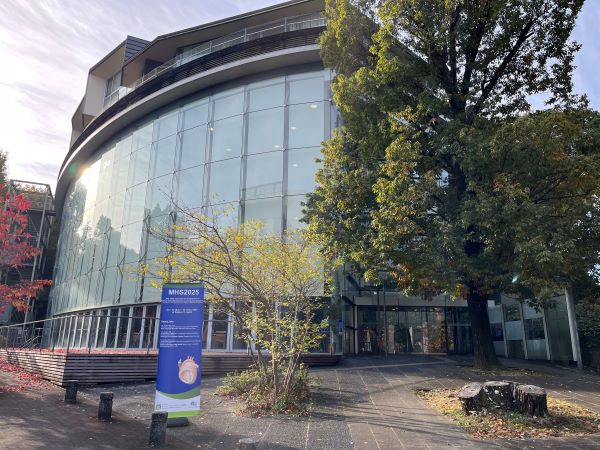Newsletter / Research Activity Report / Philip J.Atherton / Satoshi Fujita
RARA Newsletter vol. 6 The Importance of Muscle, Nutrition, Exercise, and Privacy and Diversity ... Interdisciplinary Consideration of the Expansion of Bodies and Well-being. Report on the "BKC 30th Anniversary Commemorative Symposium"
2024 / 07 / 30

2024 / 07 / 30
In this issue of the Newsletter, we report on lectures by a RARA Fellow and an Associate Fellow that attracted the interest of participants at the BKC 30th Anniversary Commemorative Symposium held on June 26 at the Rohm Plaza, Biwako Kusatsu Campus (BKC) of Ritsumeikan University.
As the real and virtual realms merge in our world, improving health, quality of life, and well-being have become pivotal priorities. To address these issues, Ritsumeikan University created a new area of research centered on sports health science, called ‘Body Sphere Research’. We will explore how various environments affect human minds and bodies and how they lead to well-being through comprehensive knowledge and interdisciplinary co-creation.
The Importance of Muscles and their Interaction with Nutrition and Exercise
RARA Fellow Philip Atherton
First, a visiting research professor and RARA Fellow Dr. Philip Atherton (Ritsumeikan University Research Organization of Science and Technology) gave a lecture titled “Muscle Mass Regulation through Exercise and Nutrition: The Effects of Aging.”
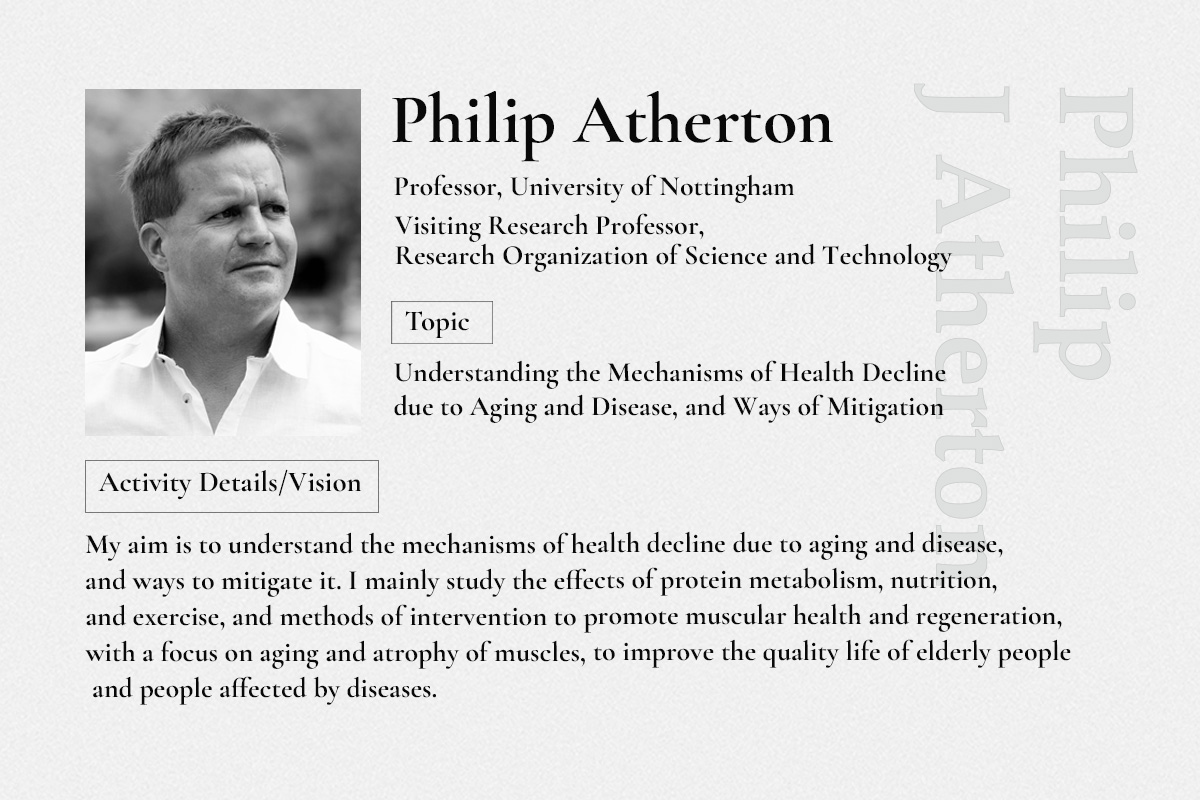
Professor Atherton’s field of study in health sciences is the mechanism of protein metabolism, which focuses on the impact of nutrition and exercise interactions on muscle health. In his lecture, he presented the results of his research on the significance of muscles and muscle synthesis and breakdown.
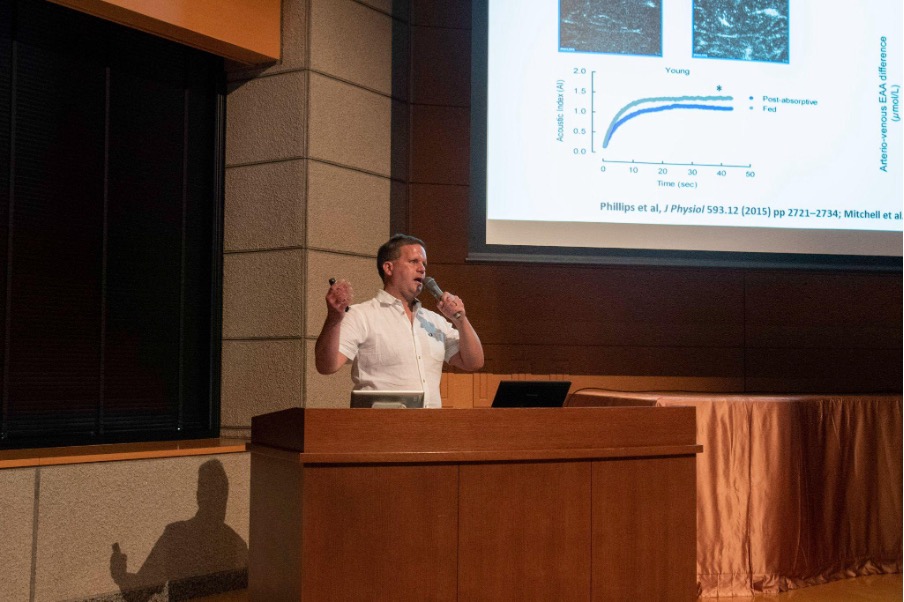
Today, I want to discuss the importance of skeletal muscle and the link between nutrition and exercise. Skeletal muscle is important for movement and mobility, and in terms of mass, it is the largest organ in the body.
The skeletal muscles have important metabolic functions. All tissues metabolize every second of every day, but skeletal muscle, in particular, is an exceptionally large reservoir of proteins and comprises amino acids obtained from our diet.
Skeletal muscles are increasingly being recognized as endocrine organs. An organ produces biological substances that act on other tissues to regulate health.
Approximately half of an individual’s body weight comprises skeletal muscles, which are important for movement, strength, balance, and posture. Diet and exercise are the main external factors that affect skeletal muscle health. Skeletal muscle plays a key role in many diseases, and even when examining the morbidity and mortality of several diseases, a decrease in muscle mass and function is linked to poor clinical outcomes.
Skeletal muscle dysfunction affects a wide range of conditions, including aging; arthritis; diabetes; obesity; cancer; serious injuries; organ failure; and diseases of the liver, heart, kidneys, and lungs.
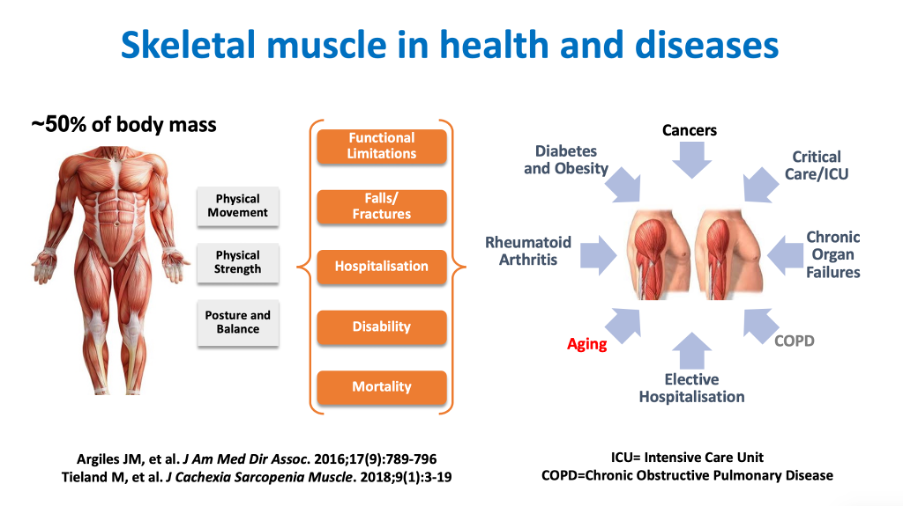
“You are what you eat.” The Relationship between Diet and Muscle
Let us examine how key environmental factors affect muscles from a nutritional perspective.
Dietary proteins are important because they contain both essential and non-essential amino acids. When proteins are broken down, the amino acids they produce are used to create new proteins in tissues, particularly in muscles. Like the phrase, “You are what you eat.”
When we obtain protein from our diet, it enters the stomach, where it is broken down into short amino acid chains, and then passes through the liver. Thus, amino acids become available in tissues through the blood circulation.
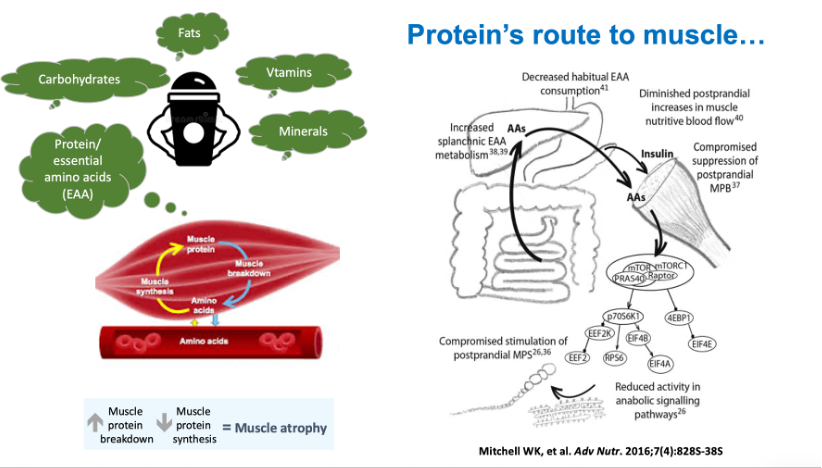
After eating a meal, both arteries and veins have high concentrations of amino acids but arteries will have higher concentration as tissues take amino acids from the arterial circulation. Blood flow increases after eating for approximately 60–75 minutes, and the concentration in the arteries is higher than that in the veins. This is because it takes approximately an hour for the muscles to absorb amino acids from dietary proteins.
For example, if you fast overnight, your muscles lose protein, but when you eat, protein synthesis increases and breakdown decreases. If this is kept constant, the muscles will retain its condition, as there will be daily protein synthesis and breakdown.
Fifteen years ago, we experimented with the relationship between protein nutrition and muscle metabolism and made important discoveries. Although protein synthesis is initiated by eating, it continues for a limited time and stops abruptly after 90 minutes. This indicated that prolonged protein consumption does not lead to continuous muscle growth.
We also found that the timing of the muscle synthesis response to the subsequent meal was approximately 3.5 to 4 hours after the previous meal.
We found that certain amino acids play a crucial role in protein production in the body. One example is the essential amino acid “leucine.” Although all amino acids are needed for protein production in the body, leucine can stimulate protein synthesis, even in the absence of other essential amino acids.
Experiments in the elderly have shown that a small amount of leucine acts similarly to a large amount of whey protein, which is considered a high-quality protein.
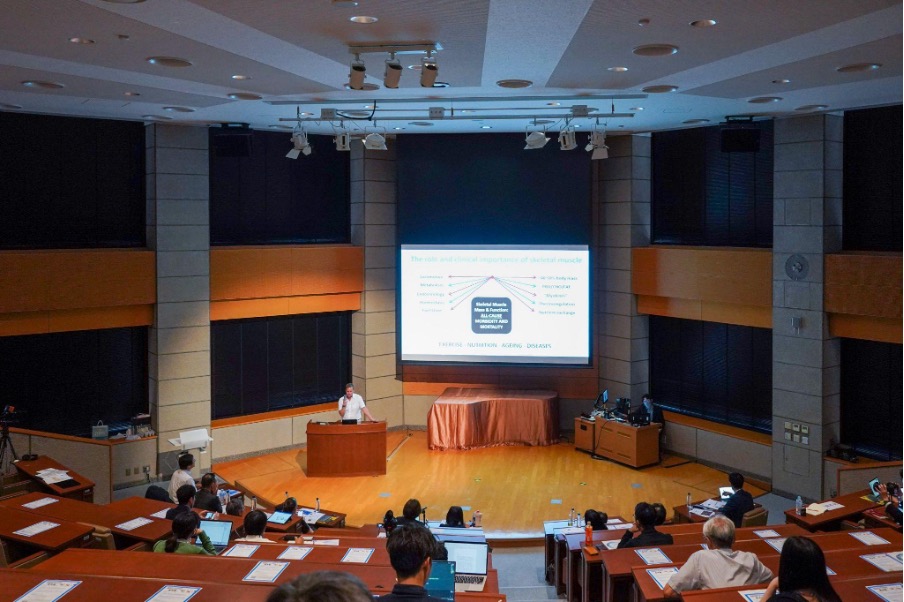
Insufficient exercise inhibits protein synthesis in muscles. Aging also has an effect.
An examination of the interactions between nutrition and exercise revealed that aligning exercise and nutrition increased the rate of muscle synthesis in a sustained manner.
In contrast, when participants who walked 6,000 steps per day reduced it to 1,500 steps, they saw a significant decrease in muscle mass, even within a short period. Inactivity inhibits the protein synthesis response.
On the effects of age, we found that the ability to synthesize proteins in tissues such as the muscles is reduced among the elderly. Elderly people have also been shown to have a lower “anabolic response” to muscle stimulation than younger people. With this point in mind, we need to consider the possibility of using external stimuli to improve muscle health in elderly individuals.
We also found that limiting exercise, such as spending time in bed even for a few days, led to reduced muscle mass, muscle thickness, and muscle strength in the thighs and other parts of the body. A significant and persistent reduction in muscle protein synthesis and metabolism was observed. This suggests that the reduction in protein “synthesis” occurs at the root of human muscle atrophy.
Amino acids obtained from dietary proteins are important for muscle maintenance and stimulate muscle protein synthesis within 2–3 hours. In contrast, insulin effectively inhibits the breakdown of muscle proteins.
Leucine is an important amino acid that is incorporated into muscle proteins and can directly promote muscle protein synthesis. Muscle protein synthesis is most effective if it receives nutrients approximately 3–4 hours after initial nutrient intake.
Aging affects skeletal muscle, and we need to understand the interplay between nutrition and lack of exercise and take measures against it. The lack of exercise inhibits muscle protein synthesis rather than increases its breakdown. Therefore, strategies that capitalize on these interactions are required.
As we age, muscle synthesis due to dietary intake slows down, and muscle mass decreases.
RARA Associate Fellow Professor Satoshi Fujita
RARA Associate Fellow Professor Satoshi Fujita of the College of Sport and Health Science, Ritsumeikan University, spoke next. Prof. Fujita reported the results of his research, including his joint research with Professor Atherton.
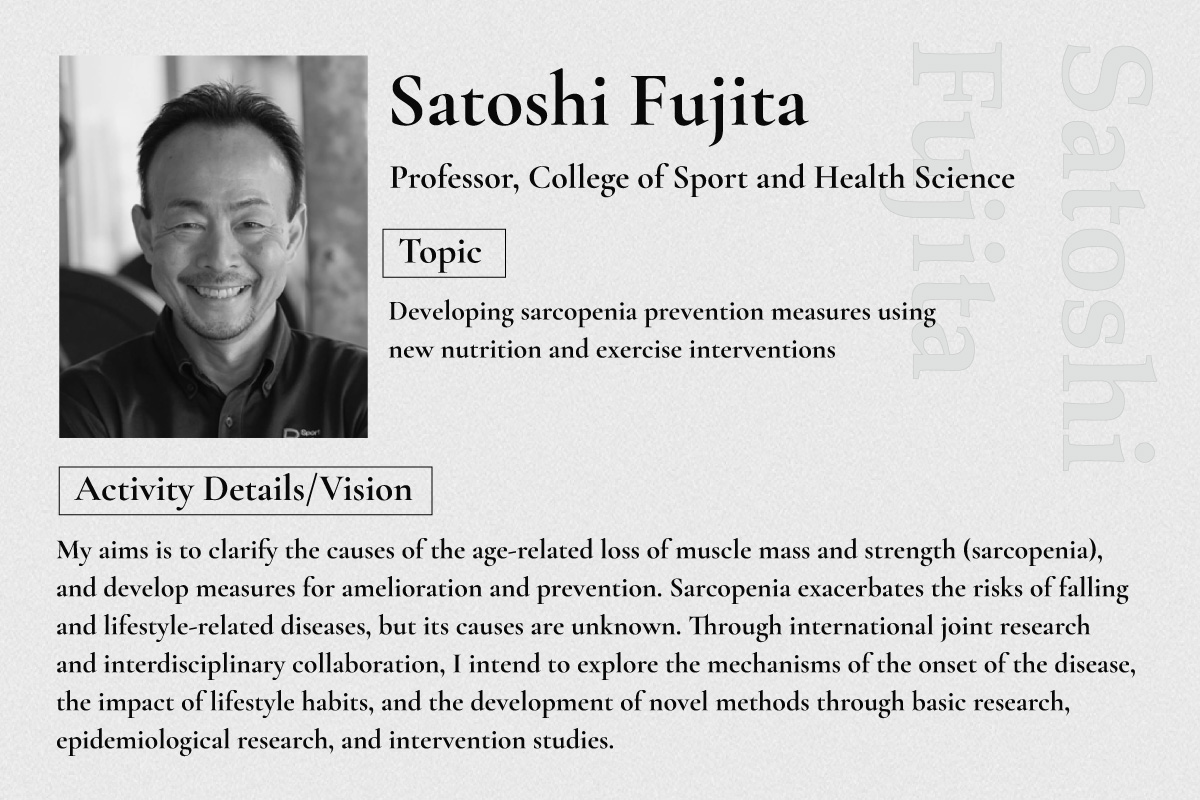
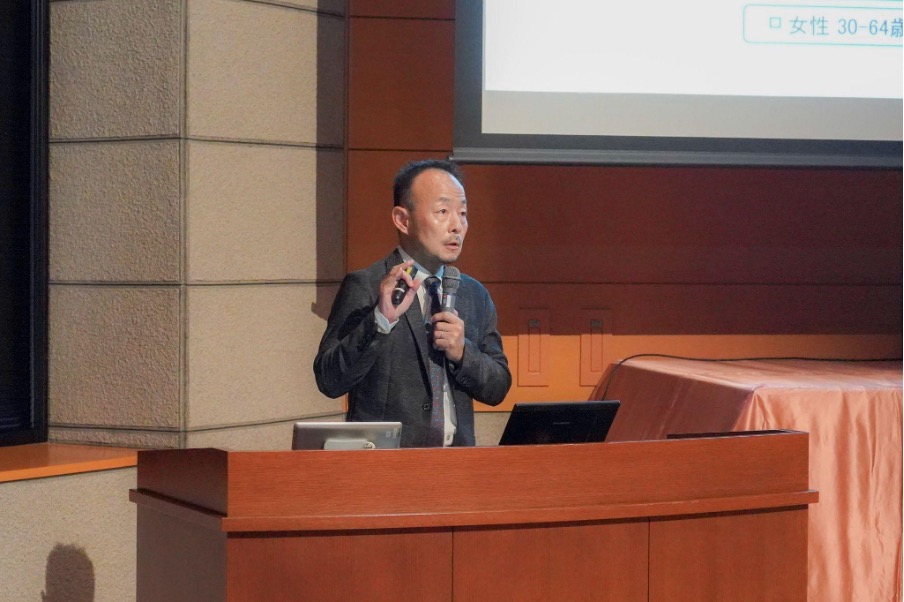
For the average adult, the average muscle synthesis and breakdown comes out even over a 24-hour period, but as you get older, it becomes harder to synthesize protein from your diet. This is called ‘Anabolic Resistance’. It has been noted that a lower response to dietary intake, especially if it continues for three meals a day, 365 days a year, may lead to a decrease in muscle mass.
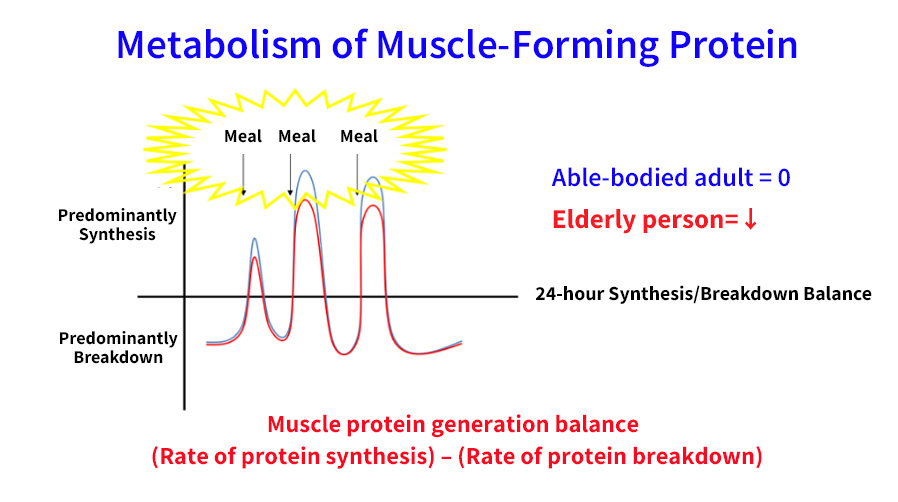
Essential amino acids are critical for enhancing muscle protein synthesis through diet. Ingesting 20 g of essential amino acids has been shown to increase the rate of protein synthesis to approximately twice that of an empty stomach one hour after ingestion.
The amino acid leucine is important, as Prof. Atherton mentioned that it stimulates protein synthesis.
Data from the US, which examined elderly people in their 70s over three years, showed that muscle mass decreases with age. With particular attention to dietary intake, the data showed that the group with the highest protein intake limited the loss of muscle mass by approximately 40% as compared with the group with the lowest protein intake. Thus, the data clearly shows that muscle strength cannot be maintained without maintaining ample amount of dietary protein.
Consume about 0.4 g of protein per kilogram of body weight equally in all three meals.
On the question of how much protein to consume per meal to maximize muscle synthesis, a meta-analysis of previous studies shows that, especially in the elderly, approximately 0.4 g of protein per kilogram of body weight; 20 g per meal for women weighing 50 kg, can maximize postprandial protein synthesis.
More than this amount may not help muscle synthesis. Conversely, consuming less than 0.4 g per kg of body weight may not maximize muscle protein synthesis for that meal.
The dietary patterns of Japanese people show inadequate protein consumption during breakfast and lunch, as a majority of protein is consumed during dinner. Data indicate that many Japanese, regardless of sex or age, do not consume 20 g of protein during breakfast. In particular, many women do not consume protein during lunch. The majority of Japanese people have been found to consume over 20 g of protein during dinner.
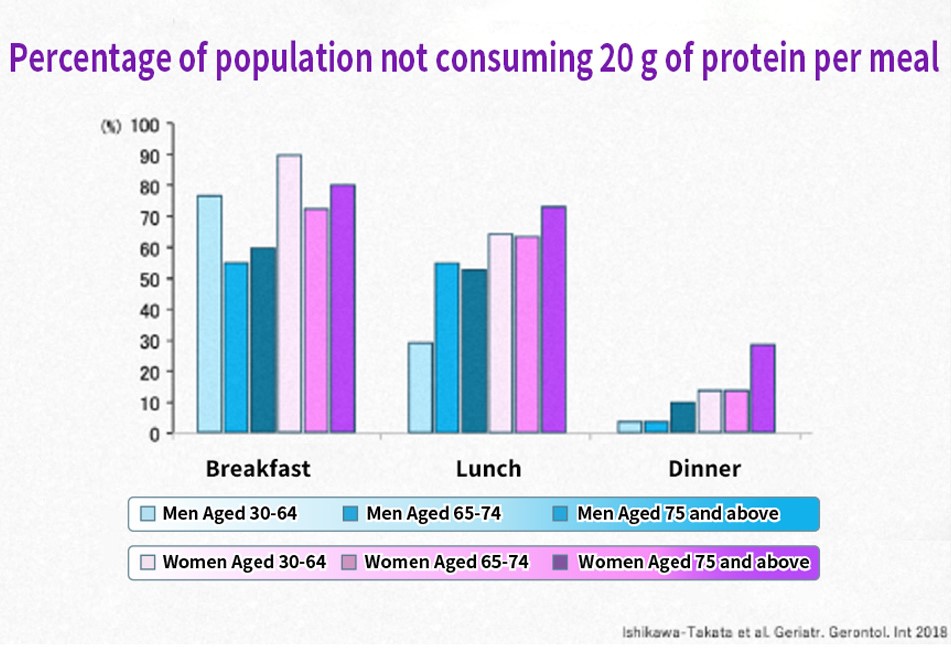
Studies in the West indicate that even if one consumes sufficient amounts of protein across three meals, an uneven distribution raises the risk of sarcopenia (muscle weakness due to loss of muscle mass).
We investigated students in Ritsumeikan University to determine the effects of these diets on muscle mass in young people. We found that even young college students are at risk of losing muscle mass if there is inadequate protein in a single meal.
Maximize training effectiveness with resistance exercise and three meals of protein.
Let us briefly discuss exercise and what is called resistance exercise. People usually believe that resistance exercise does not increase muscle mass without long-term training; however, it has been demonstrated that after taking only one session of resistance exercise, the rate of muscle synthesis doubles than that at rest.
A previous study showed that the rate of protein synthesis increased immediately after exercise, and for those who did not exercise daily, the effect of resistance exercise lasted for approximately two days. Besides the effects of exercise-induced muscle protein sythesis, the effects of exercise can be maximized by consuming proteins after muscle training.
Therefore, we studied the effect of the lack of sufficient protein at breakfast, for instance, skipping breakfast, on the training outcomes of university students. After training thrice a week for three months, we found that even with a uniform protein intake, the effects of training were maximized for students who ate protein at every meal compared to those not taking enough protein during breakfast.
I studied with Prof. Atherton the merits of consuming protein during hunger hours, in other words hours between meals. We conducted a comparative study to determine whether consuming protein six times a day as compared with three times with meals would cause a higher composition of exercise-induced protein.
Consuming protein between meals including before bedtime did not provide significant additional benefits, as long as sufficient protein was consumed during the three meals. Thus, eating sufficient protein with three meals and active exercise are important factors for good health.
Regarding nutrition, other than protein, vitamin D is an important factor that decreases the likelihood of sarcopenia. It can be produced by the human body upon exposure to ultraviolet light or sunlight, but many studies have noted that the concentration of vitamin D decreases with age. Decreased vitamin D levels are also associated with diabetes, increased body fat, Alzheimer’s disease, and decreased muscle mass.
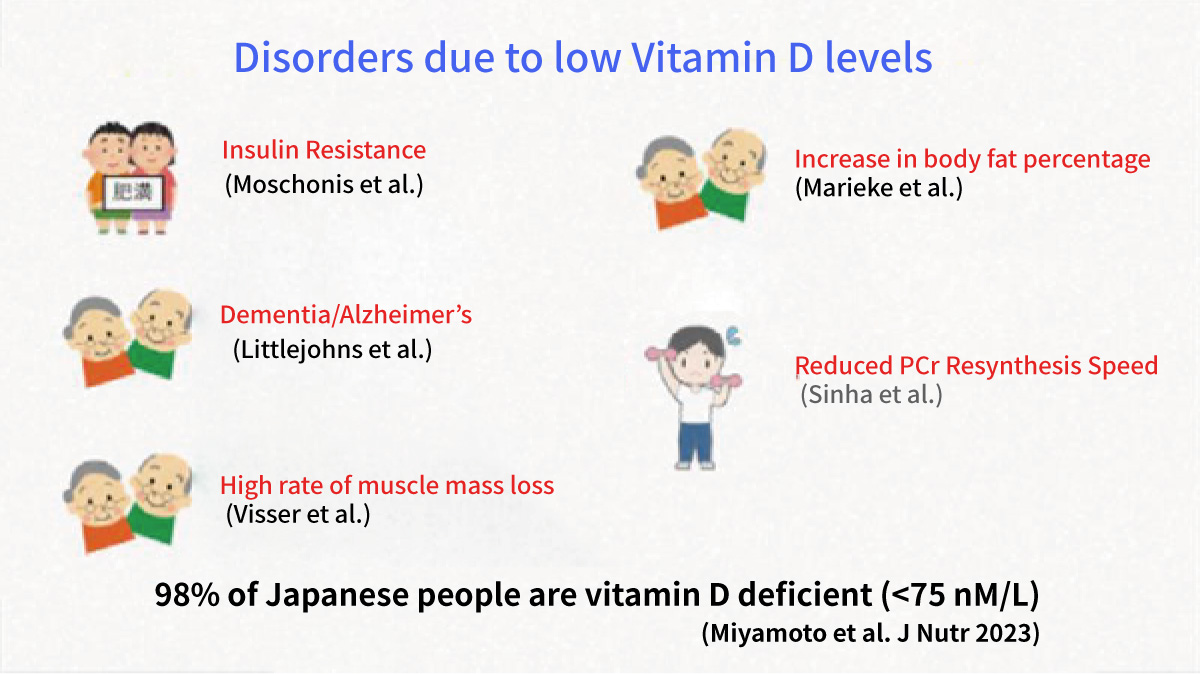
One of my collaborations with Prof. Atherton is focused on vitamin D. Basic animal studies have clearly revealed that muscle mass decreases when vitamin D is not functioning, and vitamin D receptor modulates muscle protein synthesis and muscle mass at the cellular level.
News reported that approximately 98% of the Japanese population was deficient in vitamin D last year. When considering its connection to the disease, is this not a serious problem?
One country that actively consumes vitamin D at the national level is Finland, in northern Europe. Because they have few hours of sunlight, in 2003, the government was concerned about vitamin D deficiency and implemented a policy of adding vitamin D to foods, such as milk and butter. There are reports that this has increased vitamin D intake by approximately 3–4 times.
Vitamin D is undoubtedly important for maintaining muscle mass, but the Finnish data also reveals that simply increasing its concentration does not lead to maintaining muscle mass. Exercise and protein intake are also important factors.
